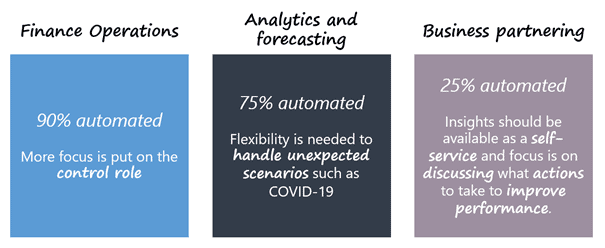We have been talking about Digital Transformation in Finance for ages. Some have come far on the journey while others are still struggling. Having just gone through a global crisis that saw everyone working remotely and using digital tools makes this transformation more relevant than ever.
Right now, we are looking at two almost extreme cases:
On one hand, we are at a stage where the transformation can be completed because of all the tools are readily available.
On the other hand, so many companies still struggle with their transformation and are challenged by even the simplest of processes such as inter-company or bank reconciliation.
How can we solve for this and complete the transformation? More importantly, how will the finance function look afterwards? Will it become 100% digitalized or will there still be humans working in this space? Let’s discuss what it takes to progress the transformation and overcome the significant hurdles that many companies are facing.
How do we solve the legacy challenge?
The main problem is that large and/or older companies suffer from old legacy ERP systems. These systems were customized to fit the exact need of the company and likely took years to implement and cost a lot of money in consultant spend.
While you can consider this a sunk cost, companies are still looking to squeeze more return from the investment and have a hard time abandoning their current system. In addition, the customization makes it very difficult (and expensive) to make changes to it. Companies are caught in a catch-22, where they are not ready to scrap their current system nor can they effectively change the current system to better fit the present-day reality.
That is why these companies are now trapped in a slow-moving digital transformation. How could they change this? Two ideas come to mind:
Build a completely new platform on the side either using a standard ERP system or picking “best of breeds” of systems that fit the exact purpose.
Take an agile approach to the transformation where piece by piece processes get digitalized using “best of breeds systems.”
The first idea is likely the safest, but also the most expensive because a separate organization must be working on the project on the side. It will also take a while before the organization sees change. In addition, you are likely to take valued finance experts out of their day job or spend significant time in workshops to aid the build of the new platform.
The second idea is riskier because pieces of the finance function will be continually moving to a better digital platform. It is likely to be cheaper though and there should be many wins along the way. Still, it would always involve most of the organization meaning the transformation becomes a way of working rather than a separate project. This requires a culture and a capability change to become more agile.
To make our decision we should remind ourselves of the speed of change we were able to create during the crisis. Suddenly things we had been talking about for years but never moved on became possible in a matter of weeks. We could change the cycle time of our reporting to provide near real-time insights and we could collaborate virtually with people all over the world for a much more effective problem-solving process.
Could we use this momentum to fuel an agile approach, where changing a system is not a matter of 12-18 months but rather something that can be done in 3 months? Could we create a digital innovation process where every two weeks a new product is released for the finance function to work more efficiently and effectively?
This is the challenge that we must give ourselves and the agile transformation could be the answer! Next week we will address how the agile trend will impact how we work and how we transform Finance.
What will happen when the transformation is complete?
The transformation will likely never be complete because there will always be better tools and systems coming to the market. That said, there are likely limits to what can be digitalized in Finance in the foreseeable future. Here is a rough view on how far we could go on the automation journey.

Today we are not where we need to be in any of these roles. Digital capabilities will greatly enhance our ability to deliver what the business needs from Finance. An efficient machine in which the people can challenge decision-makers to make better decisions and even bring their own recommendations to the table. Hence, let us try to answer the overall questions.
- Will there be humans in Finance in the future? Absolutely.
- Will they be doing something different? Most definitely.
- And no, Finance will not become 100% digitalized.
Where are you on the digital transformation journey and what role do you see for humans to play? Where is your organization at in this journey? Is your team prepared to start from where you are in that journey right now?



